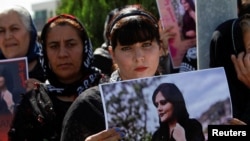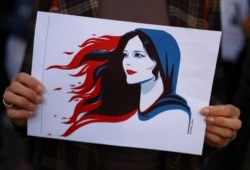Mass protests continue in Iran following the death of Mahsa Amini, a 22-year-old Kurdish woman who died after being detained by Iran’s Guidance Patrol (morality police) in Tehran earlier this month.
Tehran has framed the reaction to Amini’s death from Western media and officials as an attempt to “violate Iran’s sovereignty,” alleging a “cognitive war and hybrid warfare against the Iranian nation.”
Iran claims Amini died of heart failure. The regime says accusations that she was injured in police custody are fake news.
The Islamic Republic News Agency said:
“The western media and influencers during the recent days spent tremendous efforts aimed at aggravating the dimensions of unrests in Iran and claimed that the death of Mahsa Amini was due to the harsh dealing of the police forces against her, while the Iran Police publishing [sic] a videoclip showed that her death was due to a heart attack, proving the false news broadcasted by the western media and the anti-Iranian press.”
The claim that the video clip of Amini collapsing in a detention center “proves” she died of a heart attack is false.
Without an independent autopsy, the exact cause of Amini’s death remains unknown. But there is evidence indicating Iran’s morality police beat her for wearing a hijab in a way they found improper.
Iranian police released the CCTV video, which shows a woman they identify as Amini interacting with a female police officer at the detention center. After a brief conversation, Amini presses her hands to her head, grips a chair and collapses.
Iran has said the video refutes claims Amini was struck by police, and that she “lost her life due to heart failure.”
But witnesses did not claim she was beaten in the detention center. Rather, they allege she was beaten inside a police van after being arrested outside a metro station in Tehran on September 13.
Erfan Mortezaei, Amini’s cousin, told the U.K.’s Sky News that Amini lost her vision and fainted at the center as the result of “a concussion from a blow to the head."
Mortezaei said a witness inside the van said Amini “was tortured and insulted” during the trip to the police station.
Amini’s father also claims the CCTV footage was doctored. Doctored or not, the footage alone does not prove Amini died of heart failure.
By releasing the footage, Iranian authorities appear to be implying that if Amini had been severely injured by police, she would not have been able to walk in the detention center, interact with others, or otherwise appear “normal.”
But head trauma can express itself in many ways. Take the sport of boxing, where most fatalities result from traumatic brain injury. There have been cases where boxers appeared to recover after bouts and were able to walk on their own and conduct post-fight interviews, only to later die from brain injuries.
The Mayfield Clinic, which specializes in brain and spine surgery, said of traumatic brain injury:
“At first the person may appear fine, but their condition can decline rapidly. After the initial impact occurs, the brain undergoes a delayed trauma — it swells — pushing itself against the skull and reducing the flow of oxygen-rich blood. This is called secondary injury, which is often more damaging than the primary injury.”
Of course, this also does not prove Amini died of a head injury. However, other evidence that Amini suffered a head injury has surfaced.
The U.K.’s Guardian newspaper reported that a computed tomography (CT) scan “of Amini’s head showed a bone fracture, hemorrhage, and brain edema, seemingly confirming that she died due to being struck on the head.”
The source of those images and other medical documents is an unnamed hacktivist group that purportedly leaked the scans to the London-based Persian language broadcaster Iran International.
The documents have not been independently verified as Amini’s.
Iran International reports that the medical documents and images “corroborate earlier accounts” from hospital sources that Amini died of brain trauma following “multiple blows” to the head.
Iran International has faced criticism of bias for financial links to Saudi Arabia, Iran’s major Mideast rival. The station maintains it is editorially independent.
Other verified photographs of Amni at Kasra Hospital in Tehran, where she died, do appear to show she was bleeding from an ear and had bruising under the eyes.
A top Iranian medical official wrote to the president of Iran's Medical Council that apparent injuries visible in the photos were “consistent with the symptoms associated with a head injury and the resulting bleeding,” not a heart attack.
Doctors on social media observed that “bleeding from her ear could be [from] a blow to the head,” reported VOA’s sister news organization, Radio Free Europe\Radio Liberty.
Iran’s interior minister claimed Amini “apparently had previous physical problems.” But her family said Amini was not suffering from a known medical condition. They said hospital staff did not allow them to see her body.
Iran has tried to pin growing internal unrest sparked by Amini’s death on the West. With more than 75 demonstrators reportedly killed in clashes with security forces, internet access has been curbed, and journalists covering the events were arrested.
State media pundits claim the United States is manipulating Amini’s death to “incite ‘regime change' in Iran.”
On September 22, the U.S. Treasury Department sanctioned Iran’s morality police “for abuse and violence against Iranian women and the violation of the rights of peaceful Iranian protesters.”








